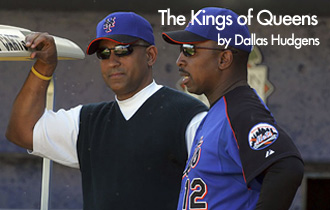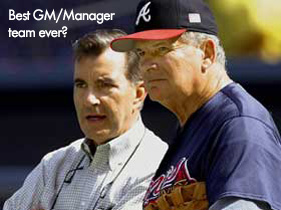The Kings of Queens: The Mets’ Dynamic Duo
13.10.06
 For the first time since 1988, the New York Mets are playing hardball deeper into October than big Stein’s Yankees. And while the tabloid scribes recuperate from a long week spent pondering the fate of the pinstripers’ beloved green-tea sipping skipper, Joe Torre, all is placid in Queens. The Mets are up 1-0 in games on the Cardinals in the NLCS, the owner is happy, and one of baseball’s best general manager/manager tandems is blessed with job security.
For the first time since 1988, the New York Mets are playing hardball deeper into October than big Stein’s Yankees. And while the tabloid scribes recuperate from a long week spent pondering the fate of the pinstripers’ beloved green-tea sipping skipper, Joe Torre, all is placid in Queens. The Mets are up 1-0 in games on the Cardinals in the NLCS, the owner is happy, and one of baseball’s best general manager/manager tandems is blessed with job security.
It may be too early to compare Mets GM Omar Minaya, 47, and field manager Willie Randolph, 52, to other great front office/dugout duos such as the Braves’ John Schuerholz and Bobby Cox, but their chemistry and success to date predicts a continued proliferation of Mets jerseys among baseball fans in the tri-state area.
Minaya, whose family immigrated to Queens from the Dominican Republic when he was a child, is one of only two minority general managers in the major leagues (The White Sox Kenny Williams is the other). He was hired by Mets owner Fred Wilpon after the 2004 season, following the team’s third straight losing record.
Minaya had already earned his reputation as a sharp evaluator of on-field talent during an earlier stint as a Mets assistant general manager from 1997 to 2001. During his time with the Mets, he interviewed for GM positions with several other teams but was never hired.
Although it’s impossible to ignore baseball’s longstanding lack of diversity in management positions, the outward criticism of Minaya was that he lacked administrative experience.
But without an opportunity to advance beyond assistant GM, how was he supposed to acquire that experience?
 Enter the orphaned Montreal Expos, a potential contraction target when its GM job opened up after the 2001 season. Only a crazy man, or someone looking to prove a point, would have taken the position.
Enter the orphaned Montreal Expos, a potential contraction target when its GM job opened up after the 2001 season. Only a crazy man, or someone looking to prove a point, would have taken the position.
Minaya had a point to prove. He took over the 90-loss Expos, whose paltry resources included a $40-million payroll, a bare-bones front office and minor league system – not to mention MLB owners for step parents – and saw the team compete for a Wild Card spot deep into the 2002 season, eventually posting a won-loss mark of 83-79, the club’s first winning season since 1996. The team matched that record in 2003, Minaya’s last as GM before Wilpon offered him the Mets’ job.
One of Minaya’s first moves was to hire Randolph as the Mets manager, replacing the recently deposed Art Howe. With that decision, Randolph became the first African-American major league baseball manager for a New York team.
Randolph already owned six World Series rings, earning two as a Yankees second baseman (1977 and 1978) and four while serving as the Yankees third-base coach from 1994-2003 (He was Joe Torre’s bench coach for the 2004 season.). A steady and quiet presence as a player during the crazed Billy and Reggie years, he had the resume and the makeup to be a major league skipper.
Nevertheless, he found himself in a similar position as Minaya. While minorities may get a shot at managerial interviews due to Major League Baseball prodding its clubs, actual job offers are entirely another matter. Randolph went through the interview process more than ten times. He was never offered a job.
Randolph was even passed over by the Mets when they hired his predecessor, Art Howe. With $5 million still owed to the axed Howe, Minaya brought Randolph on board for $1.8 million over three years before the ’05 season.
 Even Minaya had his misgivings about hiring someone who lacked managerial experience. Nevertheless, he judged Randolph’s potential rather than his experience. It also helped that Randolph had grown up in Brooklyn and spent most of his baseball career in New York. He understood that expectations were different in the land of the tabloids, and he’d never cracked beneath those expectations in all the years that he’d faced them.
Even Minaya had his misgivings about hiring someone who lacked managerial experience. Nevertheless, he judged Randolph’s potential rather than his experience. It also helped that Randolph had grown up in Brooklyn and spent most of his baseball career in New York. He understood that expectations were different in the land of the tabloids, and he’d never cracked beneath those expectations in all the years that he’d faced them.
As Minaya told the New York Times:
“When I first met Willie, he was similar to how I saw him as a player. There was always a consistency about him. I don’t remember a ball going through Willie’s legs in a big game. Everything he has done, he has either done well or he has improved at doing. He’ll have bumps in the road, but he’ll get better.”
The GM also stated early on that his and Randolph’s success would be closely linked. If he didn’t provide Randolph with the right players, then it would be just as much his fault as Randolph’s if the Mets failed to win.
Minaya reeled in the two biggest names in the free agent market before the 2005 season: outfielder Carlos Beltran and pitcher Pedro Martinez. The Mets rebounded with an 83-79 record in 2005 before posting a National League-best 97-65 mark this season while finally wresting the National League East title away from the Atlanta Braves.
The 2006 season also showed that Minaya is capable of doing more than spending the Wilpons’ money on high-priced free agents. While he did sign free-agent closer Billy Wagner, he also picked up values such as outfielder Endy Chavez and starting pitcher John Maine.
In addition, he made deals that not only strengthened the Mets but hurt their divisional rivals, acquiring Paul Lo Duca and Carlos Delgado through trades with the Marlins during that team’s salary dump, and signing the ageless Julio Franco, a former Brave, to bolster the Mets bench.
Minaya wheeled and dealed throughout the season in an effort to improve the Mets, bringing in Guillermo Mota to strengthen the bullpen and Shawn Green to add depth and another left-handed bat to the roster. Mota is a regular bullpen contributor now. And even though Green’s performance over 34 regular-season games was only fair, he carried his weight in the NLDS-clinching third game against the Dodgers, doubling twice, singling and driving in three runs against his old team.
At $101 million, the Mets payroll is the third highest in baseball behind the Yankees and Red Sox. It’s almost half of the Yankees $194-million payroll, but Wilpon is an owner who offers flexibility.
 Some of that flexibility might be needed to shore up the Mets starting pitching next year. Entering the post-season, that area appeared to be an Achilles heel the streaking Dodgers could exploit. Pedro was out not only for October but at least through the first half of next season after rotator cuff surgery, and Orlando Hernandez, whom Minaya picked up in a May trade, injured a calf muscle before his scheduled start in game 1 of the Division Series. That left 40-year-old Tom Glavine as the anchor of the rotation, a future Hall of Fame lefty who hadn’t fared so well in some of his final post-season outings with Atlanta.
Some of that flexibility might be needed to shore up the Mets starting pitching next year. Entering the post-season, that area appeared to be an Achilles heel the streaking Dodgers could exploit. Pedro was out not only for October but at least through the first half of next season after rotator cuff surgery, and Orlando Hernandez, whom Minaya picked up in a May trade, injured a calf muscle before his scheduled start in game 1 of the Division Series. That left 40-year-old Tom Glavine as the anchor of the rotation, a future Hall of Fame lefty who hadn’t fared so well in some of his final post-season outings with Atlanta.
When it became apparent that Martinez would not be pitching in the playoffs, Randolph remained calm, saying that champions don’t overreact to those kinds of losses.
On the other hand, he couldn’t help surveying the carnage of his starting rotation. His solution was to carry 12 pitchers, instead of 11, on the Mets post-season roster. He knew that relief pitching was one of the team’s strengths, and he was ready to use it, making fourteen pitching changes over the course of the three game series against the Dodgers.
Now that 40-year-old starter Tom Glavine has helped pitch the Mets to a 1-0 lead in games against the Cardinals in the National League Championship Series, the team faces possibly four more games without a day off, meaning Glavine will return to the mound on Monday after only three days rest. Even a deep bullpen will be hard-pressed to carry the load over that sort of stretch and against a lineup anchored by Albert Pujols.
Whatever the outcome against the Cardinals, it’s clear that Randolph will stay calm and Minaya will already be plotting ways to improve the Mets for next season. And considering Steinbrenner’s ultimatums, spending habits, and lack of a World Series title since 2000, it’s also apparent that front-office stability resides in Queens.
photos on page 1 and 4 from the New York Times. Photo on page 2 from Yahoo Sports. Page 3 photo from MLB.com.